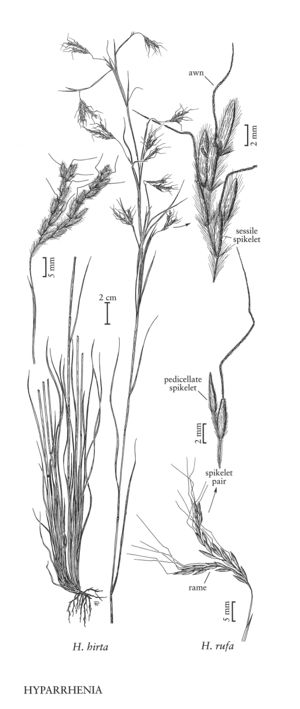Difference between revisions of "Hyparrhenia hirta"
imported>Volume Importer |
imported>Volume Importer |
||
| (One intermediate revision by the same user not shown) | |||
| Line 43: | Line 43: | ||
|publication year= | |publication year= | ||
|special status=Introduced | |special status=Introduced | ||
| − | |source xml=https:// | + | |source xml=https://bitbucket.org/aafc-mbb/fna-data-curation/src/200273ad09963decb8fc72550212de541d86569d/coarse_grained_fna_xml/V25/V25_1627.xml |
|subfamily=Poaceae subfam. Panicoideae | |subfamily=Poaceae subfam. Panicoideae | ||
|tribe=Poaceae tribe Andropogoneae | |tribe=Poaceae tribe Andropogoneae | ||
Latest revision as of 17:57, 11 May 2021
Plants perennial; cespitose but with short rhizomes. Culms 30-100 cm. Sheaths glabrous; blades 2-40 cm long, 1-3(4) mm wide. Peduncles 5-10 cm; rames 1-3.5(4) cm, 1 almost sessile, the other with a 5-10 mm base, both with 8-14 heterogamous spikelet pairs. Glumes of all spikelets densely pubescent, hairs to 0.3 mm, white to dark yellow. Sessile spikelets of homogamous pairs 4.9-5.6 mm; sessile spikelets of heterogamous pairs 4-4.5 mm; lemmas awned, awns 1-3.5 cm. Pedicellate spikelets 4.8-6.5 mm. 2n = 30, 44, 45.
Distribution
Calif., Pacific Islands (Hawaii), Tex.
Discussion
Hyparrhenia hirta is native to southern Africa, where it grows on stony soils and is sometimes used for thatching. It has been cultivated in Texas and Florida, but is not currently known to be established in the Flora region. A report of its occurrence in Los Angeles County, California, has not been verified.
Selected References
None.
